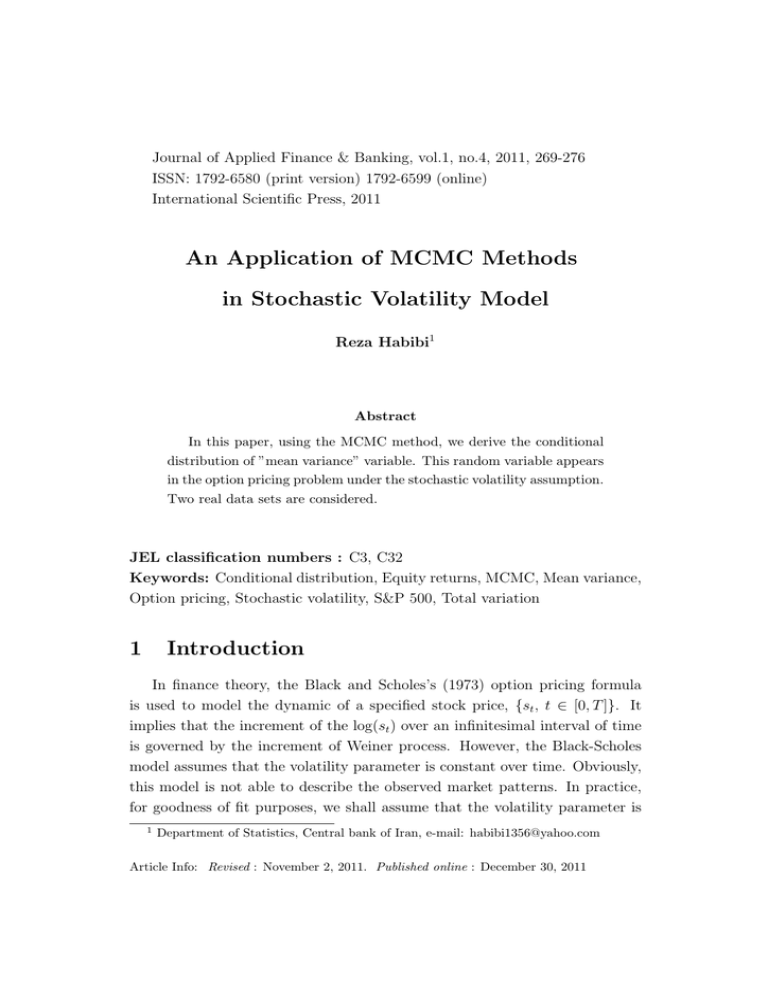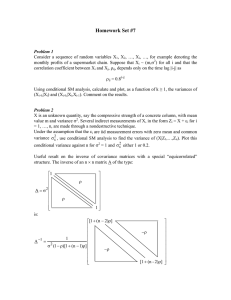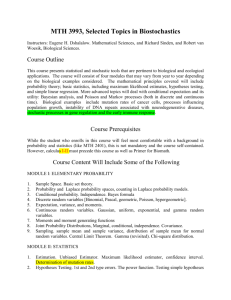Journal of Applied Finance & Banking, vol.1, no.4, 2011, 269-276
advertisement

Journal of Applied Finance & Banking, vol.1, no.4, 2011, 269-276
ISSN: 1792-6580 (print version) 1792-6599 (online)
International Scientific Press, 2011
An Application of MCMC Methods
in Stochastic Volatility Model
Reza Habibi1
Abstract
In this paper, using the MCMC method, we derive the conditional
distribution of ”mean variance” variable. This random variable appears
in the option pricing problem under the stochastic volatility assumption.
Two real data sets are considered.
JEL classification numbers : C3, C32
Keywords: Conditional distribution, Equity returns, MCMC, Mean variance,
Option pricing, Stochastic volatility, S&P 500, Total variation
1
Introduction
In finance theory, the Black and Scholes’s (1973) option pricing formula
is used to model the dynamic of a specified stock price, {st , t ∈ [0, T ]}. It
implies that the increment of the log(st ) over an infinitesimal interval of time
is governed by the increment of Weiner process. However, the Black-Scholes
model assumes that the volatility parameter is constant over time. Obviously,
this model is not able to describe the observed market patterns. In practice,
for goodness of fit purposes, we shall assume that the volatility parameter is
1
Department of Statistics, Central bank of Iran, e-mail: habibi1356@yahoo.com
Article Info: Revised : November 2, 2011. Published online : December 30, 2011
270
An Application of MCMC Methods...
a time varying stochastic function (say σt ). Because of this, the stochastic
volatility models (going back to the Hull and White (1987)) are introduced
to be extensions for the traditional Black-Scholes model. In the stochastic
volatility models, it is assumed that the volatility itself satisfies in the other
stochastic differential equation. Let vt = σt2 be the variance function and
R = log(sT /s0 ) = log(sT ) − log(s0 )
be the total variation of log-price process over time interval [0, T ].
Nowadays, stochastic volatility models are necessary instruments for analyzing asset prices (see Ghysels et al. (1996) and Shephard (2005)). These
models work very well, in practice. Characteristics of financial markets are
measured by defining quantities on these models. For example, Hull and White
(1987) introduced the ”mean variance” variable (v) in stochastic volatility series as the integral of variance function of a fixed derivative security over its
life time (i.e. T ) over T, that is,
v = (1/T )
Z
T
vτ dτ.
0
They showed that, in a risk-neutral world, the distribution of R conditional
upon v is normal distribution. They also stressed that there is no analytical
form for the distribution of v.
In this paper, following Chib et al. (2006), the price equation is given by
d log(st ) = {θ1 + θ2 σt2 }dt + σt dBt ,
t ∈ [0, T ]. Following Hull and White (1987), when ρ = 0, we can show that the
conditional distribution of R given v is N (η ∗ , λ∗2 ) where
η = (θ1 + θ2 v)T and λ2 = T v.
To see this, first assume that the variance function σt2 is deterministic and time
varying. Then
Z
Z
T
T
R=
0
{θ1 + θ2 σt2 }dt +
σt dBt .
0
In this case, it is easy to see that the distribution of R is normal with mean
and variance η ∗ , λ∗2 , respectively. Note that the parameters of this normal
271
Reza Habibi
distribution depend on vt throughout v. When σt2 is stochastic, there are an
infinite number of paths with the same v, but all of paths present the same
distribution for conditional distribution of R. This completes the proof. There
is another proof. In this case, we assume the variance changes at only n equally
spaced times in the interval [0, T ]. Let si and vi denote the price and volatility
during the i-th interval. We can see that
log(
√
si
) = {θ1 + θ2 vi }(T /n) + vi Ni ,
si−1
si
) given vi is normal
where Ni has N (0, T /n) distribution. Therefore, log( si−1
distribution with mean
{θ1 + θ2 vi }(T /n),
and variance (T /n)vi . Therefore, R given v = (v1 , ..., vn ) is normal random
variable with mean
n
X
θ1 T + θ2 (T /n)(
vi )
i=1
Pn
and variance (T /n)( i=1 vi ). By letting, n → ∞, the proof is completed. This
method of proof helps us in the case of ρ 6= 0.
One can note that v is a useful criteria to compare the situation of two
stocks. However, it is reasonable to compare the performance of two stocks,
based their mean variances, at the same levels of total variations. This fact
motivates us to derive the density of v given R = r. The MCMC method can
be applied to generate samples from this posterior distribution as follows. Note
that this type of MCMC method is referred as ”conditional diffusion process
simulation” which is appeared in Baltazar-Larios and Sørensen (2009).
(0)
1. Generate an initial unrestricted stationary sample path {vt , t ∈ [0, T ]} of
the diffusion of vt using for instance the Milstein scheme or one of the other
R T (0)
methods in Kloeden & Platen (1999). Then calculate v0 = (1/T ) 0 vτ dτ.
2. Set l = 1.
(l)
3. Propose a new sample paths by simulating {vt , t ∈ [0, T ]} and as well as
calculate vl .
272
An Application of MCMC Methods...
4. Accept the proposed diffusion with probability
min(1,
φ(r, ηl , λ2l )
),
φ(r, ηl−1 , λ2l−1 )
otherwise set v (l) = v (l−1) . Here, φ(r, ηl , λ2l ) is the density of normal distribution
with mean ηl and variance λ2l computed at r.
5. Set l = l + 1 and go to 2.
Remark 1.1. Following Smith and Gelfand (1992), there is an alternative method against MCMC approach for generating samples from posterior
distribution v given R = r as follows. Generate L sample paths {v (l) }Ll=1 and
calculate {v (l) }Ll=1 , {ηl }Ll=1 and {λ2l }Ll=1 . Therefore, compute importance weights
{wl }Ll=1 defined by
φ(r, ηl , λ2l )
.
w l = PL
2
l=1 φ(r, ηl , λl )
Finally, by re-sampling {v (l) }Ll=1 according to wl and calculating v (l) , samples
form posterior distribution is extracted.
Next, suppose that ρ 6= 0 and let vt obey the following stochastic process
dvt = µvt dt + ξvt dwt .
vi
) is normal with mean
Then, log( vi−1
µT
ξ2T
−
,
n
2n
2
si
)
and variance ξ nT . It can be seen that the conditional distribution of log( si−1
given vi is normal with mean
√
vi
vi
ξ2T
µT
{log(
+
},
)−
(θ1 + θ2 vi )(T /n) + ρ
ξ
vi−1
n
2n
and variance
vi (1 − ρ2 )T /n.
Therefore, R conditional on the path followed by {v1 , ..., vn } has a normal
distribution with mean
n
ρ X√
ξ2T
µT
vi
vi {log(
η = (θ1 + θ2 v)T +
+
},
)−
ξ i=1
vi−1
n
2n
∗
273
Reza Habibi
and variance
λ∗2 = (1 − ρ2 )T v.
Letting, n → ∞, the conditional distribution of R given {vt }t∈[0,T ] is derived.
Note that this conditional distribution depends on the path vt rather that
v. Also, note that the above mentioned MCMC method can be applied by
substituting η, λ2 with η ∗ , λ∗2 . To this end, it is necessary to generate stationary
sample paths
(l)
{vt , t ∈ [0, T ]}, l ≥ 1,
of the diffusion of vt at time points ti = iT /n, i = 1, 2, ..., n and, using the above
formulas, calculate η ∗ and λ∗2 , respectively. The variable v is approximated
by
n
X
(1/nT )
vi .
i=1
This paper is organized as follows. Two real data sets S&P 500 and U.S.
equity returns are considered in section 2.
2
Real data sets
In this section, we apply the mentioned MCMC to two real data sets. They
are (1) Standard and Poor’s 500 index (S&P 500) and (2) U.S. equity returns.
Example 2.1. The daily returns data on closing prices of the S&P 500
are accessible and valuable time series. The prices of 500 large-cap common
stocks (actively traded in the U.S.) are aggregated in this weighted index. We
consider this time series from 5/5/1995 to 14/4/2003. Following Chib et al.
(2006), we consider the GARCH form for the variance process vt defined by
dvt = θ4 (θ5 − vt )dt + θ3 vt dwt .
Using the generalized method of moments (Iacus (2008)), the estimates of
parameters θ2 and θ4 are zero approximately and (θ1 , θ32 , θ5 , ρ) = (0.022,
0.029, 3.09, -0.84). Here, Bt and wt are two standard Brownian motions on
[0, T ] such that cor(Bt , wt ) = ρ. This parameter is called leverage factor. The
θ32 T
θ2 T
vi
) is normal with mean − 2n
and variance 3n .
marginal distribution of log( vi−1
274
An Application of MCMC Methods...
Under this information, we find that the conditional distribution of R given
{v1 , ..., vn } is normal with mean
n
vi
θ2 T
ρ X√
vi {log(
) + 3 },
θ1 T +
θ3 i=1
vi−1
2n
and variance (1 − ρ2 )T v. The conditional expectation of v given R = r, E(v|r),
are 0.012, 0.0139 and 0.0144 for r = 0.039, 0.05 and 0.055, respectively. It is
seen that this index has little conditional average volatility and therefore it is
a good siuation.
Remark 2.2. Chib et al. (2006) also considered the log-normal form for
variance process given by
dvt = θ4 vt (θ5 − log(vt ))dt + θ3 vt dwt .
Here, θ1 ' 0. The estimates of parameters are θ2 = 0.021, θ32 = 0.033, θ4 =
0.027, θ5 = 0.72 and ρ = −0.83. It is easy to see that the logarithm of vt is
Ornstein-Uhlenbeck process, that is
dyt = c(µ − yt )dt + σdwt ,
where c = θ4 , µ = θ5 −
where
θ32
2θ4
and σ = θ3 . Therefore, log(vt ) is normal N (κt , π22 ),
κt = e−ct [y0 + µ(ect − 1)] and πt2 =
σ2
(1 − e−2ct ).
2c
It is easy to see that
σ 2 −c(s+t) 2c min(s,t)
cov(ys , yt ) = e
(e
− 1).
2c
vi
) is normal with mean ιi = κti − κti−1 and variance
Therefore, log( vi−1
ϑi = πt2i + πt2i−1 − 2
si
cov(yti , yti−1 ).T heconditionaldistributionof log( si−1
) given vi is normal with
mean and variance
p
(T /n)vi
vi
) − ιi },
{θ1 + θ2 vi }(T /n) + ρ √
{log(
vi−1
ϑi
and
(1 − ρ2 )T v,
respectively. We consider this volatility process in the following example.
275
Reza Habibi
Example 2.3. This example is taken from Andersen et al. (2002). The
price equation is given by
d log(st ) = θ1 dt + σt dBt ,
where the log-volatility process αt = log(σt2 ) follows the Ornstein-Uhlenbeck
process
dαt = −θ4 (αt − θ5 )dt + θ3 dwt .
The parameters estimates are
θ1 = 0.03, θ3 = 0.125, θ4 = 1.389, θ5 = 0, and ρ = −0.62.
The values of E(v|r) based on r = 0.55, 0.78 and 1.035 are 0.022, 0.0339 and
0.0244, respectively.
ACKNOWLEDGEMENTS. The author is grateful to the referee for
several suggestions for improving the paper.
References
[1] T. G. Andersen, L. Benzoni and J. Lund, An empirical investigation of
continuous time equity return models, Journal of Finance, 57, (2002)
1239-1284.
[2] F. Baltazar-Larios and M. Sørensen, Maximum likelihood estimation for
integrated diffusion processes, Research paper, School of Economics and
Management, University of Aarhus, (2009), 1-14.
[3] F. Black and M. Scholes, The pricing of options and corporate liabilities,
Journal of Political Economy, 81, (1973), 635-654.
[4] S. Chib, M.K. Pitt and N. Shephard, Likelihood based inference for diffusion driven state space models, Working paper, School of Business, University of Washington, (2006), 1-33.
276
An Application of MCMC Methods...
[5] E. Ghysels, A. C. Harvey and E. Renault, Stochastic volatility. In C. R.
Rao and G. S. Maddala (Eds.), Statistical Methods in Finance, (1996),
119-191.
[6] J. Hull and A. White, The pricing of options on assets with stochastic
volatilities, Journal of Finance, 42, (1987), 281-300.
[7] S.M. Iacus, Simulation and inference for stochastic differential equations:
with R examples, Springer, 2008.
[8] N. Shephard, Stochastic Volatility, Selected Readings, Oxford University
Press, Oxford, 2005.
[9] A. F. M. Smith and A. E. Gelfand, Bayesian statistics without tears: a
sampling re-sampling perspective, The American Statistician, 46, (1992),
84-88.






